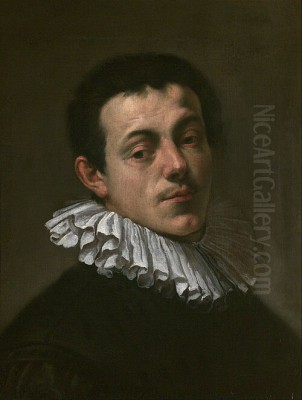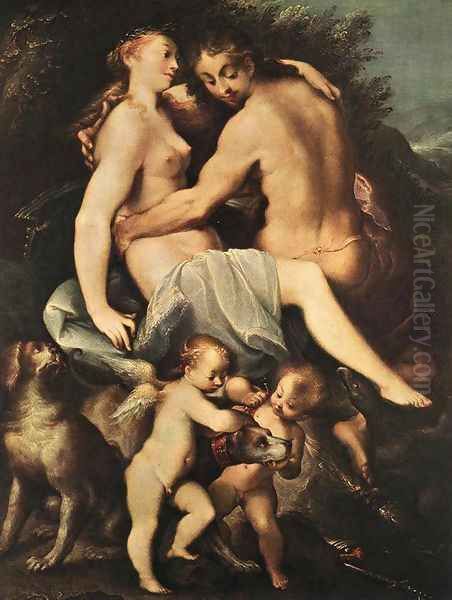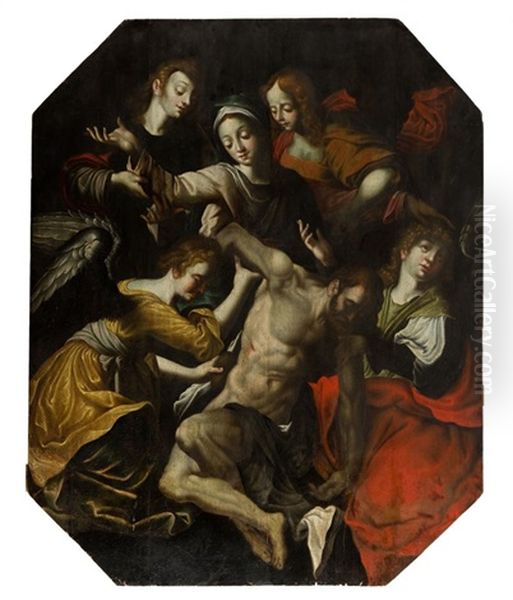
Joseph Heintz the Elder stands as a significant artist of the late 16th and early 17th centuries, a period of vibrant artistic transition in Europe. A Swiss-born painter, draftsman, and occasional architect, Heintz masterfully navigated the complex currents of late Renaissance and burgeoning Baroque styles, becoming a prominent figure at the imperial court of Rudolf II in Prague. His oeuvre, characterized by an elegant fusion of Italianate grace and Northern European precision, primarily encompassed mythological scenes, religious subjects, and insightful portraiture, leaving an indelible mark on Central European art.
Early Life and Artistic Formation in Basel
Born on June 11, 1564, in Basel, Switzerland, Joseph Heintz (also known as Josef Heintz der Ältere) was immersed in an artistic environment from a young age. His father, Daniel Heintz the Elder, was a respected architect and stonemason, whose work on the Münster (Cathedral) in Bern and other significant structures likely provided Joseph with his initial exposure to the principles of design and construction. This familial background in the building arts would later manifest in Joseph's own architectural contributions.
Basel, at the time, was a notable cultural and intellectual hub, still resonating with the legacy of Humanism and the presence of figures like Erasmus. It had also been a center for artists such as Hans Holbein the Younger, whose meticulous realism and psychological depth had set a high standard for Northern European art. Heintz's formal artistic training began under the tutelage of Hans Bock the Elder, a local painter. However, it is widely documented that Heintz was a diligent student of past masters, and he dedicated considerable effort to copying the works of Hans Holbein the Younger, a practice that undoubtedly honed his technical skills and his eye for detail. This early grounding in the Northern tradition, with its emphasis on precise rendering and often sober subject matter, would form a crucial foundation upon which his later, more flamboyant style would be built.
The Transformative Italian Sojourn

Like many ambitious Northern European artists of his generation, Heintz recognized the indispensable value of experiencing Italian art firsthand. Between 1584 and 1587, he embarked on a formative journey to Italy, spending a significant portion of this period in Rome. This was a pivotal experience, exposing him to the monumental achievements of the High Renaissance masters and the sophisticated, often intellectually charged, art of Mannerism.
In Rome, Heintz absorbed a wealth of influences. He studied the powerful anatomical forms and dynamic compositions of Michelangelo, the harmonious grace and idealized beauty of Raphael, and the dramatic chiaroscuro and intense naturalism of Caravaggio, who was then an emerging force. Through his compatriot and fellow artist Hans von Aachen, who was also active in Italy, Heintz became intimately acquainted with the sensuous, elegant, and often emotionally charged works of Emilian masters like Correggio and Parmigianino. The elongated figures, complex poses, and refined eroticism characteristic of Parmigianino's style, and Correggio's mastery of soft, sfumato effects and tender expressions, resonated deeply with Heintz and would become hallmarks of his mature work. He also encountered the works of Venetian painters like Titian, whose rich color and painterly technique were highly influential. The exposure to such a diverse array of artistic genius profoundly shaped his aesthetic sensibilities, encouraging a move towards greater dynamism, elegance, and a more sophisticated handling of the human form.
Heintz was not merely a passive observer; he actively sketched and copied, internalizing the principles of Italian design, composition, and thematic interpretation. This period was crucial in developing his distinctive style, which sought to synthesize the meticulous detail of his Northern training with the grandeur, elegance, and expressive freedom he encountered in Italy. He also spent time in Florence and Venice, further broadening his artistic horizons.
Court Painter to Rudolf II in Prague
The culmination of Heintz's early career and his Italian studies came in 1591 when he was appointed court painter to Emperor Rudolf II in Prague. This was a prestigious position, placing him at the heart of one of Europe's most eccentric and culturally vibrant courts. Rudolf II was an avid collector and patron of the arts and sciences, deeply interested in alchemy, astrology, and the occult. His court attracted a constellation of artists, scholars, and craftsmen from across Europe, including notable figures like Bartholomeus Spranger, Hans von Aachen (who also joined the Prague court), and the sculptor Adriaen de Vries.

Prague under Rudolf II became a leading center for late Mannerism, often referred to as Rudolfine Mannerism. This style was characterized by its sophistication, intellectualism, refined eroticism, and often complex allegorical content, perfectly suited to the emperor's esoteric tastes. Heintz thrived in this environment. His ability to blend Italianate elegance with a Northern sensibility for detail made him a favored artist. He was tasked with creating a variety of works, from official portraits of the emperor to mythological and allegorical paintings that adorned the imperial collections.
His role was not confined to Prague. Rudolf II also dispatched him back to Italy on art-buying expeditions, notably in 1592 (to Rome) and again between 1603 and 1604, demonstrating the emperor's trust in Heintz's connoisseurship and his connections within the Italian art world. These trips allowed Heintz to refresh his knowledge of Italian art and acquire works for the imperial collection.
Artistic Style: A Synthesis of North and South
Joseph Heintz the Elder's artistic style is a fascinating amalgamation of diverse influences, primarily characterized by the elegance and artifice of late Mannerism, yet grounded in a Northern European attention to detail. His figures are often elongated, with graceful, sinuous lines and complex, sometimes contorted, poses that display a sophisticated understanding of anatomy, albeit one often stylized for aesthetic effect. This elongation and elegance are particularly indebted to artists like Parmigianino.
Heintz demonstrated a remarkable versatility in his choice of subject matter. His mythological paintings, often imbued with a subtle eroticism, were particularly well-suited to the tastes of the Rudolfine court. These works frequently feature luminous, pearlescent flesh tones, intricate compositions, and a delicate, refined finish. He had a keen sensitivity to the play of light, using it to model forms and create a sense of atmosphere, a skill perhaps sharpened by his awareness of Correggio and early Caravaggesque tendencies.
His palette could range from rich, jewel-like colors in his oil paintings to more subtle and nuanced tones in his drawings, where he often employed red and black chalk, sometimes heightened with white. His draftsmanship was exceptional, characterized by fluid, confident lines that defined form with both precision and grace. This skill is evident in his preparatory sketches as well as finished drawings, which were often collected as artworks in their own right.
While deeply influenced by Italian art, Heintz never entirely abandoned his Northern heritage. There is a certain precision and clarity in his work, a careful rendering of textures and details, that speaks to his early training. This fusion resulted in a style that was both internationally sophisticated and possessed of a distinct personal character. He was less inclined towards the dramatic intensity of the burgeoning Baroque, favoring instead a more refined, courtly aesthetic.
Masterpieces and Thematic Concerns
Joseph Heintz the Elder produced a significant body of work, though, like many artists of his era, attributions can sometimes be complex. His paintings and drawings are found in major museums and collections across Europe and North America.
Mythological and Allegorical Works: This was perhaps his most celebrated genre.
Venus at her Toilet (also known as The Toilet of Venus): Several versions exist, showcasing his skill in depicting the female nude with sensuous elegance. These compositions often draw on the refined aesthetics of artists like Parmigianino and the Venetian tradition. One notable version, a drawing in red and black chalk, was sold at Sotheby's in New York in 1989 and is now in a private collection. It exemplifies his mastery of chalk, with delicate modeling and graceful lines.
Nymphs and Satyrs: A painting now in the Metropolitan Museum of Art, New York, is a prime example of his mature Rudolfine style. It depicts a lively, somewhat risqué scene typical of the mythological subjects favored by the court, rendered with his characteristic elegance and attention to detail.
Cupid Leaving Psyche: Housed in the Germanisches Nationalmuseum, Nuremberg, this work explores a popular Ovidian theme, allowing Heintz to display his talent for narrative and the depiction of idealized human forms in dynamic interaction.
Adonis Parting from Venus (Kunsthistorisches Museum, Vienna): This painting captures a moment of poignant farewell, a theme that allowed for the expression of tender emotion alongside the depiction of classical beauty. The composition and the rendering of the figures reflect his deep engagement with Italian models.
Religious Paintings: While mythological scenes were prominent, Heintz also created religious works.
Pieta with Angels: This subject, treated by many artists, allowed Heintz to explore themes of grief and divine suffering, often imbued with a quiet pathos that contrasts with the more exuberant mythological scenes. He blended Italianate compositional structures with a Northern European emotional sensibility.
The Virgin and Child with Mary Magdalene: A work noted in the Elisha Whitelsey collection and later in private hands, it demonstrates his capacity for devotional imagery, likely rendered with the same refined technique seen in his secular pieces.
Saint Michael: Religious subjects like this provided opportunities for dynamic compositions and the depiction of spiritual power, often drawing on High Renaissance prototypes for heroic figures.
Portraiture: Heintz was also an accomplished portraitist.
Portrait of Rudolf II as Holy Roman Emperor (Kunsthistorisches Museum, Vienna, c. 1594 and other versions): This is one of his most famous works. It presents the enigmatic emperor in full regalia, a commanding and iconic image that captures both the majesty of the office and something of Rudolf's introspective character. The meticulous rendering of the imperial insignia and the rich fabrics showcases Heintz's Northern attention to detail, while the overall composition and pose have a formal dignity rooted in Italian state portraiture traditions, influenced by artists like Titian or Anthonis Mor.
He also painted other members of the court and aristocracy, though these are less frequently cited than his imperial portraits.
His drawings, often in red or black chalk, or a combination, frequently heightened with white, are highly prized. They reveal his working process and his innate skill as a draftsman, with a fluidity and confidence that is immediately apparent. These drawings were not merely preparatory; many were considered finished works of art.
Architectural Pursuits
Reflecting his father's profession and perhaps a broader Renaissance ideal of the versatile artist, Joseph Heintz the Elder also engaged in architectural design, particularly in the later part of his career. His most notable architectural achievement is his involvement in the design of the east facade of the Augsburg Town Hall (Rathaus). While Elias Holl is the primary architect associated with this magnificent Renaissance structure, Heintz is credited with contributing significantly to the design of its elaborate facade.
This foray into architecture demonstrates his multifaceted talents and his understanding of classical principles of proportion and ornamentation, likely honed during his Italian studies where he would have encountered the architectural masterpieces of antiquity and the Renaissance by architects like Bramante, Michelangelo, and Palladio. His architectural work, though less extensive than his painting, underscores his comprehensive artistic vision.
Contemporaries, Collaborations, and Workshop
At the cosmopolitan court of Rudolf II, Joseph Heintz the Elder worked alongside a distinguished group of international artists. His relationship with Hans von Aachen was particularly significant; they were compatriots who had both spent formative years in Italy and later became key figures in the Rudolfine artistic circle. Their styles, while distinct, shared a common grounding in Italian Mannerism and a sophisticated, courtly elegance.
Bartholomeus Spranger, a Flemish painter, was another leading artist at Rudolf's court, known for his highly stylized, erotic, and allegorical works. While their individual approaches differed, they all contributed to the unique artistic climate of Prague. Adriaen de Vries, the Dutch sculptor, also created masterpieces for the emperor, often sharing thematic concerns with the painters.
Heintz collaborated with other artists on occasion, and like many successful painters of his time, he likely maintained a workshop to assist with commissions and to train pupils. One important associate was Matthäus Gundelach, a German painter who worked with Heintz and, after Heintz's death, became the guardian of his widow and children, suggesting a close personal and professional relationship. Gundelach also continued to work in a style influenced by Heintz and the Rudolfine aesthetic.
The influence of earlier masters remained a constant. Beyond the Italian giants, the legacy of Northern Renaissance artists like Albrecht Dürer and Lucas Cranach the Elder, with their technical mastery and distinct German character, would have been part of the broader artistic consciousness, even if Heintz's style leaned more towards Italianate forms. His early study of Hans Holbein the Younger certainly left a lasting impact on his precision.
His son, Joseph Heintz the Younger (1600–1678), also became a painter, primarily active in Venice, where he was known for his festive scenes and mythological subjects, carrying on the family's artistic legacy, albeit in a different stylistic milieu influenced by later Venetian Baroque painting.
Later Years and Legacy
Joseph Heintz the Elder's productive career was relatively short. He died in Prague on October 15, 1609, at the age of 45, near the village of Hradčany, close to Prague Castle. Despite his premature death, his impact was considerable.
He is remembered as one of the most accomplished and representative artists of Rudolfine Prague, a key figure in the dissemination of late Mannerist ideals in Central Europe. His ability to synthesize Italian elegance with Northern precision created a distinctive and influential style. His portraits of Rudolf II remain iconic images of the emperor, and his mythological paintings are celebrated for their refined sensuality and technical brilliance.
His works are preserved in major museums worldwide, including the Kunsthistorisches Museum in Vienna, the Alte Pinakothek in Munich, the National Gallery in Prague, the Metropolitan Museum of Art in New York, the Germanisches Nationalmuseum in Nuremberg, and the Uffizi Gallery in Florence (which holds some of his drawings). His drawings, in particular, are highly valued by connoisseurs for their spontaneity and technical mastery.
While the specific prices for his works at auction are not always widely publicized for older sales, pieces attributed to him or his workshop occasionally appear on the art market. For instance, The Toilet of Venus drawing was auctioned at Sotheby's in New York in 1989. The painting Nymphs and Satyrs has a provenance that includes appearances at various sales and galleries over time. The value of his works reflects his historical importance and artistic skill.
Joseph Heintz the Elder's contribution lies in his role as a cultural conduit, skillfully blending artistic traditions and creating works that epitomized the sophisticated, intellectual, and somewhat decadent atmosphere of Rudolf II's imperial court. He remains a vital figure for understanding the complex artistic landscape of Europe around the turn of the 17th century, a period that saw the culmination of Mannerism and the dawn of the Baroque era. His art continues to fascinate for its elegance, technical prowess, and its window into a unique historical moment.